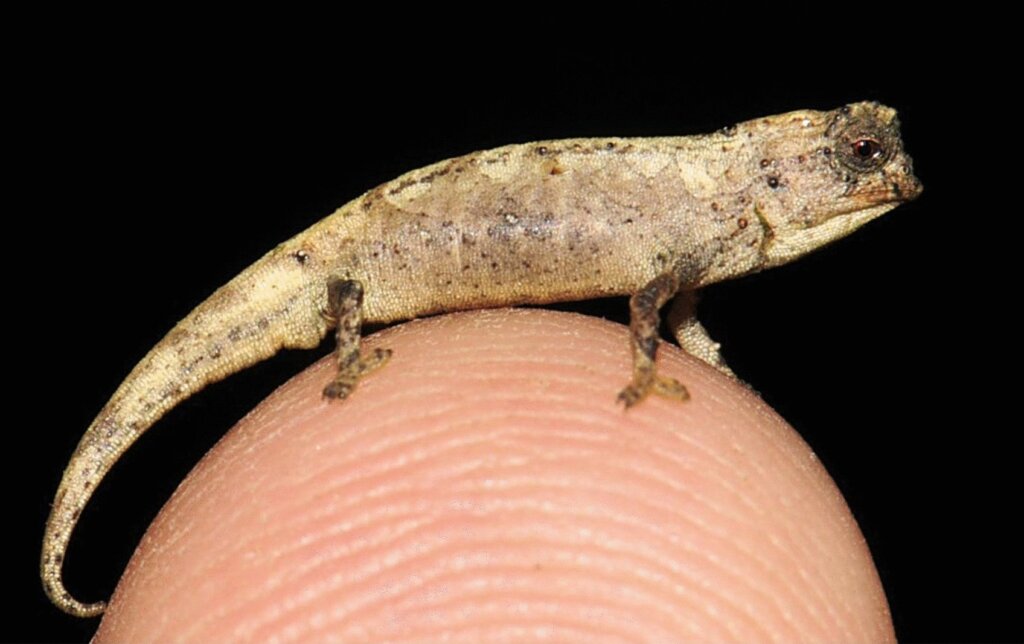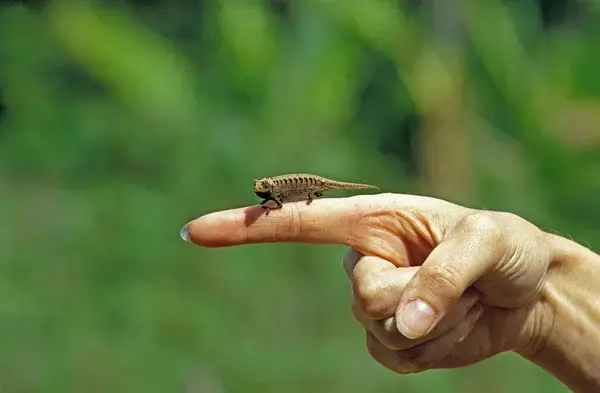A New Chameleon is the World's Smallest Reptile

In Madagascar, they’ve recently discovered the world’s smallest reptile. It’s a tiny chameleon that fits easily onto the tip of your finger! Although the females are larger than the males, neither sex reaches 3 centimeters (1.2 inches) in length.
These findings challenge the assumptions of scientists and raise more questions than answers. What evolutionary role does this small reptile play? Does its environment play a role in the adaptation of this species? In this space, we’ll tell you everything we know about these small reptiles, so don’t miss it.
Madagascar, home of tiny reptiles
Madagascar is the largest island in the Indian Ocean and is located off the southeast coast of Africa. Its flora and fauna are unique, as it’s home to a large number of endemic species. Thanks to its 80 million years of isolation in the ocean, its species have followed an evolutionary path that’s very different to their African counterparts.
80% of the species living in Madagascar are endemic, i.e. they aren’t found anywhere else in the world.
This island, besides being home to the world’s smallest reptile, is also home to the largest species of chameleon. Its scientific name is Furcifer pardalis and it’s known as the panther chameleon. The males, which are larger than the females, measure more than half a meter (1.6 feet) in length and inhabit various enclaves within the island of Madagascar, as well as Mauritius and Reunion.
So, how could the world’s smallest and largest chameleon coexist on the same island? Biologists are still investigating, and, although the answer isn’t yet clear, findings point to convergent evolution and environmental pressure. Read on.
What is the world’s smallest reptile?
The chameleon genus Brookesia, which has the smallest species of this reptile, has been known in Madagascar for years. In 2021 a study was published detailing the discovery of a new species of this genus, named Brookesia nana.
These small reptiles are the smallest known to date. Their length, including the tail, is no more than 3 cm (1.2 inches). This means that if you place them on your fingertip, there’s plenty of room for them to fit.
Sexual dimorphism and its biological meaning
These tiny chameleons show a clear sexual dimorphism in terms of size. Males are smaller than females, they measure around 21 millimeters while females reach almost 29.
It has been found that, to compensate for this size difference during copulation, the male’s hemipenes are quite large in size relative to his body (occupying 18.5% of his size).
In general, male chameleons tend to be larger than females, as they’re territorial in nature, and body size plays a key role in defending the terrain. However, with the Brookesia nana, it’s the opposite, suggesting that this species has a milder temperament when it comes to territoriality. Females, therefore, must be larger in order to produce eggs.
Theories on the size of Brookesia nana
When experts are asked about the adaptive advantages of holding the record for the world’s smallest reptile, the most widely accepted theories revolve around evolutionary convergence. Because Madagascar has been isolated for so long, species eventually adapt to the particular ecosystem they live in.
Although miniaturization seems unlikely on an island as large as Madagascar, the fact is that these reptiles occupy very small ecological niches. In fact, the known range of Brookesia nana covers only a few hectares of wooded area, so it could be a valid hypothesis.
Newly discovered and already endangered

This curious discovery brought with it some unfortunate news: the small area it occupies is threatened by deforestation. Like many other endemic species that live in small areas (like the salamander, for example), Brookesia nana shows a high specificity when it comes to adapting to its environment.
This is dangerous for the small chameleon, as losing its distribution area would be a death sentence. Currently, the inclusion of this reptile on the endangered species list is being considered in order to protect it.
For the time being, the area it inhabits has been declared as protected. This is a small step towards guaranteeing the survival of the world’s smallest reptile, but we mustn’t let our guard down. Any small action is important when it comes to saving both the big and small wonders of this world.
All cited sources were thoroughly reviewed by our team to ensure their quality, reliability, currency, and validity. The bibliography of this article was considered reliable and of academic or scientific accuracy.
- Glaw, F., Köhler, J., Hawlitschek, O. et al. Extreme miniaturization of a new amniote vertebrate and insights into the evolution of genital size in chameleons. Sci Rep 11, 2522 (2021). https://doi.org/10.1038/s41598-020-80955-1
- Das Nano-Chamäleon: Ein neuer Super-Winzling unter den Reptilien | Zoologische Staatssammlung München. (2021, 4 febrero). Zoologische Staatssammlung München. Recuperado 16 de mayo de 2022, de https://www.zsm.mwn.de/2021/02/04/das-nano-chamaeleon-ein-neuer-super-winzling-unter-den-reptilien/